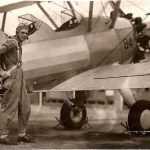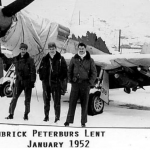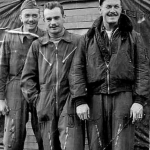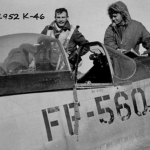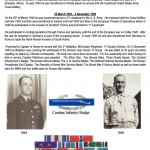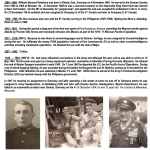Joseph Peterburs was born November, 25, 1924 in St. Paul, Minnesota, though he grew up mainly in Wisconsin, against the backdrop of the Great Depression. He comes from a family with a military tradition; his father emigrated to the United States from Germany in 1906, and joined the army that same year, completing overseas service in the Philippines and the Great War, as well as on the Mexican Punitive Expedition. Joe grew up in a large family; he and his brothers did what they could to support the family in the lean years of the Depression, and they all served in the military. As a young boy, Joe attended Catholic school, and when he felt he had a calling to the priesthood he went into the seminary. Joe was there during the early years of the war, and when the Japanese attacked Pearl Harbor on December 7, 1941 he chose to enlist. At first he tried the navy, but Joe eventually decided upon the Army Air Corps, and he became an aviation cadet, sworn in on his 18th birthday and hoping to become a “knight of the air”. Joe went into training and was selected as a pilot candidate, where he passed the courses as he moved from one field to the next. He earned his wings, and was ready to be shipped overseas by the end of 1944. At that point, Joe began flying missions in his P-51 Mustang, which he named Josephine. His principal job was to escort and protect the bombers, but he also flew ground support missions, looking for targets of opportunity. On April 10, 1945, Joe experienced one of his most memorable days of the war; he took on a German jet fighter – a Messerschmidt 262 – in a dogfight, and he succeeded in downing it. Later that day, Joe himself was hit, and was forced to bail out over Germany. He was captured and sent to Stalag 11, but in the chaos of 1945 Germany he managed to escape, and he was able to link up with Russian forces and fight with them against the Germans for a brief period. The war was in its last days at that point, and Joe was able to rejoin American forces, and from there he was shipped back to the USA in short order, where he married and began his postwar life, which did end up including the air force as a career choice. Joe did deploy in both Korea and Vietnam, and served in many capacities around the US. Joe’s Cold War service also included being on high alert during the Cuban Missile Crisis, and an overseas deployment to Germany in the 1970s. Many years later, Joe’s WWII service came back in an unexpected way when he was able to connect with the Me262 pilot he shot down during the war, and the two of them became friends. Crestwood students and staff were lucky to meet Joe via zoom in July 2021.
Videos
Click next video below to keep watching
- 1. Prewar Memories
- 2. Enlisting and Training
- 3. Going Overseas
- 4. The Missions
- 5. April 10
- 6. Escape; The Russians
- 7. Back in the USA; A Letter from Germany
- 8. Postwar Readjustment and Remembrance
- 9. Back in the US - A Career in the Air Force
- 10. Segregation and Integration
- 11. Korea
- 12. Communism and the Cold War
- 13. Command and Control; Cuba
- 14. Vietnam
- 15. The Antiwar Movement
- 16. Germany
- 17. Retirement; Sharing the Story

